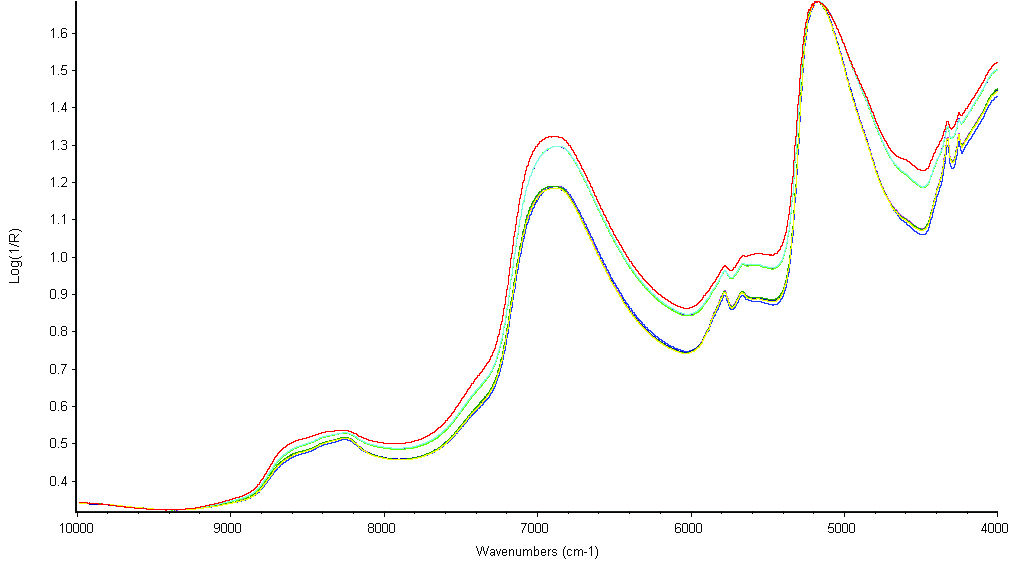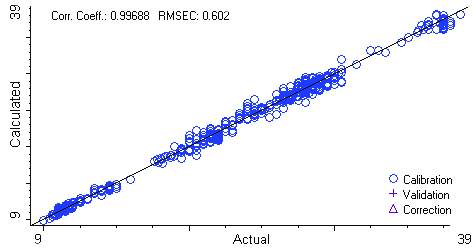The international cheese market produces billions of pounds of cheese annually, making it one of the largest food industries worldwide. Cheese and other dairy products are regularly tested for components like fat, moisture, protein, and dry matter content. These factors affect the taste, price, and manufacturability of the cheese—making their prediction critical. In the current study, a cheese producer needed to be able to quickly examine and accurately predict the amounts of fat and dry matter in cheese products.
Current protocols for the prediction of components like fat involve the Babcock method. This method uses concentrated sulfuric acid to break dairy components down before analysis. In addition, the Babcock procedure requires a skilled operator running multiple samples destructively in order to give an average number for each component. Procedures like the Babcock method are not only time consuming, but require hazardous materials. In addition, they destroy the sample being analyzed so the sampling methodology cannot be designated as truly representative of the whole.
Dry matter analyses use infra-balances or microwave driers that are rapid, but their accuracy is inferior than even classical gravimetric determination.
The amount of time, materials, and labor involved with testing cheese on a large scale can be greatly reduced by incorporating analytical QC solutions like FT-NIR into the testing protocol. For example, the Thermo Scientific Antaris FT-NIR analyzer provides accurate alternative to current testing protocols for cheese. FT-NIR testing can be extended to other components like moisture or protein that involves another complicated testing protocol, the Kjeldahl method. The Antaris FT-NIR analyzer allows for the collection of a single spectrum in less than 60 seconds without damaging the sample. In addition, multivariate analysis techniques allow the user to predict multiple components (properties) of the cheese from the same single spectrum.
It is necessary to stress that this study used different kinds of processed cheeses—non-fat, middle fatty, fatty, all with different flavors and additives. Differences in temperature of the samples were also intentionally ignored because any precollection treatment of the samples eliminates the advantage of FT-NIR’s speed of determination.
Experimental
Blends of 50–200 kg of raw materials (water, butter, cottage cheese, and additives) were tested for fat content and dry matter during agitation in melting pots. Hot aliquots of processed cheese were scanned using the Antaris FT-NIR analyzer from 4000 to 10,000 cm-1 at a resolution of 8 cm-1. Eighty scans were taken per sample resulting in an acquisition time of approximately one minute. Each sample was placed on the integrating sphere sapphire window and collected three times. The window was cleaned in between measurements using 96 percent ethanol and dried before each sample. Spectral averaging was then used for the three replicate measurements for both standard and challenge samples to achieve an average component value.
Calibration models for the data were developed using the Thermo Scientific TQ Analyst chemometric analysis software. The model used a constant pathlength and a first derivative treatment of the spectral data without smoothing. The wavelength range from 4450 to 8700 cm-1 was used with a one-point baseline. The number of standards used in the calibrations was 477 for fat and 479 for dry matter.
Results and Discussion
Figure 1 at top shows NIR spectra of some of the standards used in the calibration. There are broad, highly-absorbing water peaks around 5000 cm-1 (combination band) and 7000 cm-1 (overtone). There are also relatively sharp C-H combination bands  from 4230 to 4490 cm-1 and second overtones of C=O groups from 5620 to 5950 cm-1. In addition, there is a considerable amount of scattering from these samples evidenced by the baseline offsets.
from 4230 to 4490 cm-1 and second overtones of C=O groups from 5620 to 5950 cm-1. In addition, there is a considerable amount of scattering from these samples evidenced by the baseline offsets.
The first method quantifies fat in the blend, 477 standards between 10 and 38.7 percent wt. were used. The TQ Analyst region wizard suggested the region between 4235 and 5836 cm-1. The calibration was first done with 6 PLS factors yielding a Root Mean Square Error of Calibration (RMSEC) of 0.996 and a Root Mean Square Error of Cross Validation (RMSECV) of 1.07. These two parameters are good indicators of how well a calibration is performing. The RMSEC shows how close the standards are to the calibration curve—the closer the better. RMSECV shows how robust the calibration is. If only a few standards represent the most important variability in the method, then this will show up as a large RMSECV value. High RMSECV values imply a weak calibration that can be remedied by adding standards or changing method parameters. The method was improved when the region was changed to 4449–8709 cm-1 using the first derivative of the spectra and a one-point baseline. This yielded a calibration, using 8 PLS factors with an RMSEC of only 0.602 and an RMSECV of 0.779.
RMSECV value. High RMSECV values imply a weak calibration that can be remedied by adding standards or changing method parameters. The method was improved when the region was changed to 4449–8709 cm-1 using the first derivative of the spectra and a one-point baseline. This yielded a calibration, using 8 PLS factors with an RMSEC of only 0.602 and an RMSECV of 0.779.
Figure 2 above is a plot of the calibration curve for analysis of fat in cheese by FT-NIR spectroscopy. The Predicted Error Sum of Squares (PRESS) plot shows an optimum pattern with high PRESS at low factors and low PRESS at higher numbers of factors (Figure 3 at right).
The second method quantifies dry matter in the blend, 479 standards with values between 31.36 and 53.65 percent wt. were used. The optimized method included the region from 4075 to 8909 cm-1 with a first derivative spectral pretreatment and a one-point baseline. The calibration yielded an RMSEC value of 0.645 and an RMSECV of 0.776. Figure 4 at bottom is a plot of correlation and a part of the calibration results. Again, with a calibration set of over 400 samples, the dry matter calibration shows an excellent correlation with the reference data. The PRESS plot for dry matter was also very reasonable.
also very reasonable.
Conclusions
FT-NIR can offer an ideal alternative to traditional methods for determination of fat and dry matter in processed cheeses during their manufacture. The user is able to obtain the data quick enough for control of (feedback to) the process of raw materials and additives blending in melting pots, resulting in saving raw materials and sustaining a constant quality of products. In addition, FT-NIR is a non-destructive technique that allows collection of a single spectrum for the prediction of multiple chemical or physical properties in a sample. This methodology could be extended to predict other critical factors in cheese processing, such as total protein or moisture content—obviating the need for more involved testing protocols.
Hirsch is manager of research & advanced development at Thermo Fisher Scientific in Madison, Wis. For questions, contact 608-276-6234. Tenkl and Hollein both work at Nicolet CZ ltd. in Prague, Czech Republic. Reach them at tenkl@nicoletcz.cz and hollein@nicoletcz.cz.

Leave a Reply